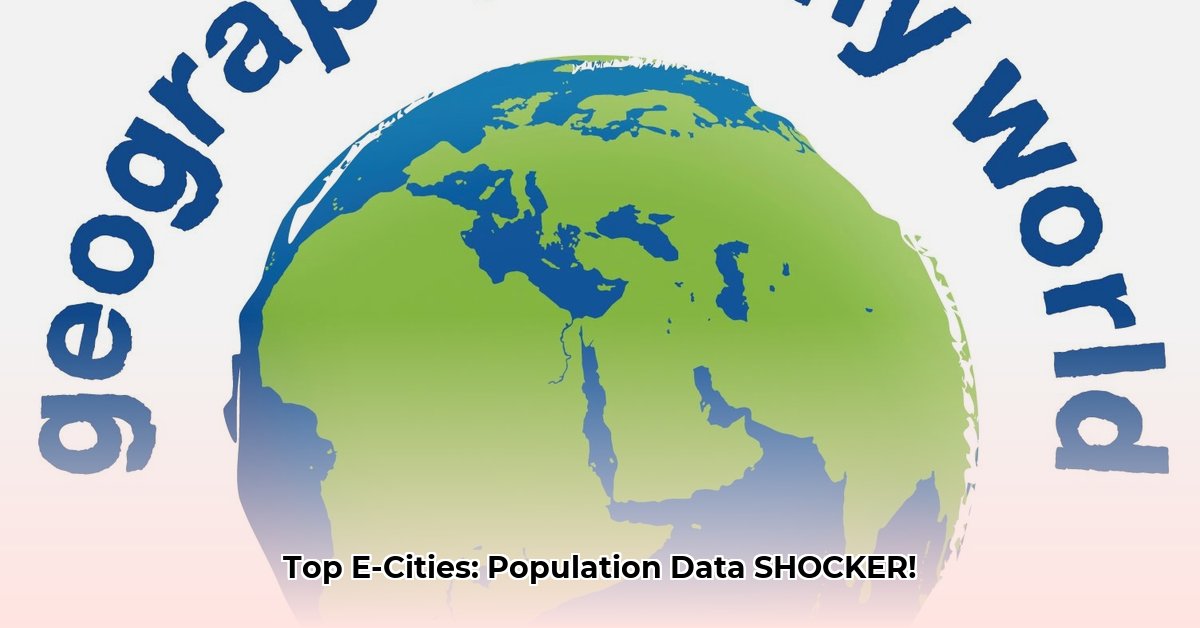Geography games can be a fun way to learn about the world, but when it comes to cities starting with the letter “E,” things can get tricky. Different sources often present conflicting population figures, leading to confusion and frustration. For a comprehensive list of “E” cities, check out this helpful resource: Largest “E” Cities. This article aims to unravel the complexities of population data for “E” cities, providing insights into why discrepancies occur and offering guidance for navigating the world of urban demographics. Our goal is to equip you with the knowledge to excel in geography games and beyond, armed with reliable information and a critical eye.
The “E” City Population Puzzle: Deciphering Discrepancies and Finding Accuracy
Have you ever encountered conflicting population figures for cities starting with “E” while playing a geography game? You’re not alone! The quest for reliable population data for these urban centers can be surprisingly challenging. It’s not just about minor discrepancies; consistent and accurate information is vital for effective learning and building trustworthy resources. This article aims to clarify the confusion surrounding “E” city populations, empowering you to navigate the complexities of urban demographics.
Unveiling the Numbers Game: Causes of Population Data Divergence
Why do population figures for the same city often differ across various sources? The answer lies in the diverse methodologies and data used by different organizations. Imagine trying to measure the area of a park using only aerial images versus ground surveys—the results would likely vary. Similarly, city population counts depend on who’s doing the counting, the methods they employ, and even how they define the “city” itself. Do the varying population counts stem from inconsistent urban area parameters?
Several factors contribute to these discrepancies:
- Defining City Boundaries: Some sources include sprawling suburbs in their population counts, while others adhere strictly to city limits. This inconsistency in defining what constitutes a “city” leads to significant variations.
- Data Collection Timelines: Population numbers are dynamic, constantly fluctuating due to births, deaths, and migration. Data collected at different times will naturally yield different results. A census conducted last year might be significantly different from a projection made today.
- Data Source Reliability: Not all data sources are created equal. Some rely on official government statistics, which are generally considered more reliable, while others utilize estimates from various organizations or even crowdsourced information, which can be prone to biases and inaccuracies.
Spotlight on “E” Cities: A Comparative Look at Population Figures
To illustrate the challenges, let’s examine some notable “E” cities and compare their population figures from various sources. We’ve prioritized data from reputable sources to provide our best estimates, but inherent uncertainties remain. Remember, these figures are snapshots in time, subject to constant change.
| Rank | City | Country | Population (Estimated) | Reliability Notes |
|---|---|---|---|---|
| 1 | Ecatepec | Mexico | 1.65 Million | Official census data may lag behind actual population growth. Metropolitan area population is significantly larger. |
| 2 | Edmonton | Canada | 1.15 Million | Generally reliable data, but consider the metropolitan area for a broader picture. |
| 3 | Erbil | Iraq | 1.0 Million | Figures from reputable sources are relatively stable. Consider the impact of regional instability on population estimates. |
| 4 | El Paso | USA | 678,815 | Consistent data across credible sources. Population growth has been relatively stable. |
| 5 | Essen | Germany | 593,085 | Data is frequently updated by reliable German governmental sources. Population decline has been observed in recent years. |
| 6 | Edinburgh | United Kingdom | 564,000 | Consistent data across credible sources. Population growth has been relatively stable. |
| 7 | Ezhou | China | 716,000 | Figures can vary depending on the inclusion of surrounding areas. Economic growth has driven population increases |
| 8 | Eskişehir | Turkey | 860,000 | Rapid urbanization has contributed to population growth. Consider regional variations in population density. |
| 9 | Enugu | Nigeria | 907,000 | Population estimates vary widely, highlighting challenges in data collection. Rapid urban growth is a significant factor. |
| 10 | Eindhoven | Netherlands | 238,326 | Consistent data across credible sources. International students and workers contribute to population stability. |
Keep in mind:
- Population figures represent estimates, not absolute certainties. They are always subject to change.
- Surveying methodologies can influence population counts. Variations in data collection techniques can lead to different results.
- It’s challenging to determine a definitive population number. The complexities of urban demographics make it difficult to pinpoint exact figures.
Enhancing Geography Skills: Improving Data Accuracy and Accessibility
The inconsistencies in city population data are not just a concern for geography enthusiasts; they affect researchers, urban planners, and anyone relying on accurate urban statistics. Can improved data quality lead to more effective urbanization models and resource allocation strategies?
Here’s how we can improve accuracy and access to population data:
- Promote Data Transparency: Data sources should be clearly identified, with transparent methodologies, allowing users to assess the reliability of figures.
- Establish Standardized Definitions: Developing universally-accepted definitions of city boundaries is crucial for meaningful comparisons. Clear guidelines would minimize ambiguity.
- Implement Regular Updates: Population data should be updated frequently (ideally more than annually) to reflect demographic changes accurately. Real-time updates would enhance data relevance
- Foster Collaboration and Open Data Initiatives: Collaboration between data providers and data users is crucial. Open access for scrutiny, correction, and improvement promotes higher data accuracy.
- Emphasize Critical Evaluation: Encourage users to evaluate data sources critically, considering methodologies, biases, and potential errors. Informed users are better equipped to interpret data accurately.
Improving the accuracy of city population data requires a multifaceted, continuous approach. The next time you encounter a population figure in a geography game or research project, remember the complexities behind the numbers.
- Exotic Girl Names Reflecting Diverse Cultures And Unique Beauty - December 11, 2025
- Exotic Female Names Offer Cultural Richness and Unique Sounds - December 10, 2025
- Exotic Baby Girl Names Evoking Far-Off Lands and Beauty - December 9, 2025










